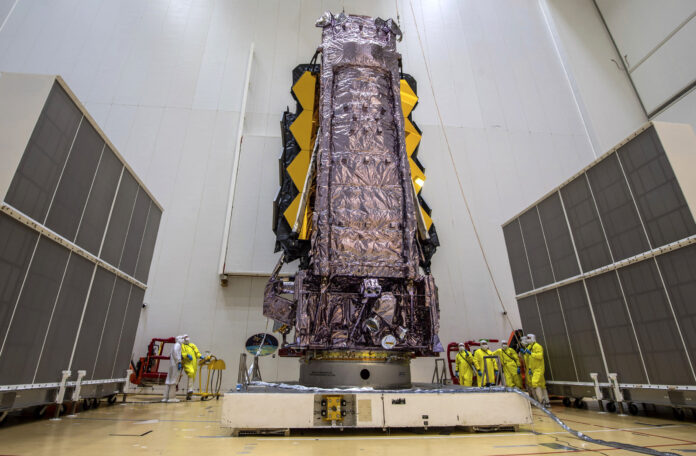The James Webb Space Telescope is on the verge of its Christmas Day launch. It’s just over a million miles away from Earth and ready to make its way toward its final destination: L2, the second sun-Earth Lagrange point.
Webb is now in commissioning mode, checking off key steps to make sure the $10 billion observatory is fully prepared for science. Next up is the delicate alignment of 18 mirror segments on its primary mirror.
Also Read: French 25m long capitaltuckereustartups
What is the James Webb Telescope?
Webb, the successor to Hubble, launched in December 2021 and took 29 days to travel 1.5 million miles to a point in space where it is balanced between the gravity of the Earth and the Sun. It is located much farther from Earth than Hubble and contains a tennis-court-sized sun shield that keeps the telescope cold, which is necessary for viewing infrared light.
The James Webb Space Telescope (JWST) is a large, infrared-optimized telescope built to study the formation of stars and galaxies. The mission is designed to investigate the evolution of galaxies, star and planet formation, the production of elements by stars, and a variety of other topics.
It is based at the NASA Goddard Space Flight Center and is managed by the Space Telescope Science Institute. It is a joint project between NASA, the European Space Agency (ESA), and Canada’s Space Agency.
At its launch, Webb was the largest space observatory ever built. It is 6.5 meters wide and features 18 hexagonal gold-coated beryllium mirror segments that can be adjusted individually. The design was developed to reduce costs and improve performance at near-infrared wavelengths between 1 and 2 micrometers.
During its alignment phase, Webb’s mirror segments were aligned one by one to focus the beam of light and capture images. Once the mirrors were aligned, Webb began to collect data and started its science mission.
When the first set of JWST images were released in July, they amazed astronomers across the world. They featured mesmerizing shots of nebulae, galaxy clusters and even the early universe itself.
They showed that Webb’s powerful infrared eyes can peer deep into nebulae and reveal dusty clouds of gas, allowing scientists to get a glimpse of nebulae’s birth to death stages, which will help them understand the process of star formation.
The images also revealed the earliest stages of galaxies, and revealed how our own Milky Way galaxy was once so young that it was still forming stars within its nebulae. Scientists will be able to see how our own galaxy was formed, and will be able to learn more about the evolution of the entire universe.
The James Webb Telescope Launch Countdown
The James Webb Telescope is a huge new piece of space technology that’s set to revolutionize astronomy. After being launched on December 25, the telescope will soon arrive at its ultimate destination: L2, or the second Lagrange point, a gravitationally stable location that’s almost 1 million miles (1.5 million kilometers) away from Earth.
After the launch, engineers and astronomers will orchestrate a series of deployments to get Webb from its folded position to a full-sized observatory. You can follow Webb’s progress on NASA’s Where is Webb website, which uses real-time telemetry from the spacecraft to provide a precise picture of where the telescope is and what stages its deployment is in.
Today, scientists and engineers began the final steps of the deployment process, moving Webb’s aft radiator to its final position. They also folded out the two side mirror segments, or wings, that make up its primary mirror.
This unfolding is a critical step for the James Webb Telescope, because it will allow scientists to take measurements that they can then use to calibrate the mirrors. The mirrors are the heart of the observatory, allowing it to capture images of the universe in both optical and infrared wavelengths.
Meanwhile, scientists are eagerly waiting to begin their science observations with Webb. They are hoping to study exoplanets, which are the planets that orbit other stars outside our solar system. The new telescope should be able to observe their atmospheres in great detail, something Hubble couldn’t.
The telescope’s next major milestone will be its arrival in orbit around L2, or the second Lagrange point, which is a gravitationally stable place in space that’s nearly a million miles (1.5 million kilometers) from Earth on the opposite side of the sun. This vantage point will help Webb stay cold and allow its instruments to operate at maximum efficiency.
The telescope’s launch countdown has started and it’s expected to lift off from Kourou, French Guiana on Dec. 24 at 7:20 a.m. EST, according to an announcement from NASA and the European Space Agency. However, there’s a chance the spacecraft may roll back to a previous date if weather at Kourou prevents it from launching on time.
The James Webb Telescope Arrives at L2
After a long trip from Earth, the James Webb Telescope finally arrived at L2, a gravitationally special spot that will give it a view of the Universe like no other telescope. The 6.5-metre-wide telescope, which weighs in at around US$10 billion, can spend 20 or more years observing deep space and gathering unprecedented insights into our awe-inspiring Universe.
The observatory arrived at L2 by going through a series of orbital maneuvers, or course correction burns. These were designed to ensure that Webb doesn’t overshoot its final destination, which would require turning it back toward Earth and potentially overheating its instruments.
Webb’s L2 orbit is crucial to its mission, as it provides a largely unobstructed view of space and gives the telescope a cold, interference-free position that helps its instruments live up to their full potential. In order to work as it was designed, the telescope has to stay extremely cold – around 40 kelvins (-233 degrees Celsius), which is nearly identical to the temperature of space.
This is a big deal because it means Webb won’t be exposed to the Sun’s room-temperature heat, which could overheat its instruments and cause them to stop working properly. It also gives Webb an advantage over Earth-orbiting telescopes, which need to rely on sunlight to power their instruments and help them function.
Eventually, Webb will use this cold position to pick up on ultra-faint heat signatures that aren’t available from Earth-orbiting telescopes like Hubble. These “heat vision” observations are critical to the telescope’s ability to study the early Universe and learn more about how stars and planets formed.
For its first few months at L2, Webb will spend a lot of time aligning its 18 mirror segments to act as one large 6.5-metre telescope, and then testing its science instruments. Once it’s all aligned, astronomers will start taking their first pictures.
For its first few images, the JWST will focus on a single star called HD 84406, located in the constellation Ursa Major. This is a G-type main sequence star, which is similar to our own Sun. The star is just a few thousand light years away and is in the midst of its final stages of life as it blows out huge amounts of gaseous winds into space, compressing those to form dust.
The James Webb Telescope Starts Science
Once Webb was in orbit, NASA’s astronomers began to work with their instruments to create scientific images. They’ll use the telescope to see the early universe, the formation of stars and galaxies, planetary systems and exoplanets in distant places.
This image of a star-forming region in the Orion sky was one of the first scientific images released by Webb. It shows a star called HD84406 that’s formed in an intricate, hexagonal structure. The 18 individual stars haven’t yet aligned, but as they do over the coming months, they’ll eventually merge into a single star.
Another spectacular shot was this one of a cluster of galaxies 4.6 billion light-years from Earth. Astronomers are interested in the SMACS 0723 cluster because it’s large and powerful, and it bends and magnifies the light from other galaxies. It also contains a huge gaseous cloud of dust that is forming new stars.
The dusty shells of this cluster are created by Wolf-Rayet stars that are on the cusp of their death. The winds from these stars are so huge that they billow up into space, causing clouds of rusty dust to form.
That’s why astronomers had to build a special telescope to capture infrared light. To do that, the instrument needed to be operated at a temperature of about -233degC (40deg above absolute zero), which required entirely new instrument designs.
Infrared light is invisible to the human eye, but it can give astronomers important information about what’s going on in a star-forming cloud of dust or a galaxy’s core. Scientists can then see what elements are produced in these star-forming regions and how hot they are, for example.
As a result, the James Webb Telescope is expected to be a “game-changer” in the study of our universe. It will allow astronomers to take a closer look at the birth of stars, the evolution of galaxies and planets, as well as to search for exoplanets and the presence of cold dark matter.
The most complex and expensive telescope ever built, Webb has had its share of delays and cost overruns. But its first images are a milestone for NASA, and for scientists around the world who have waited years to view our cosmos with this powerful instrument.









